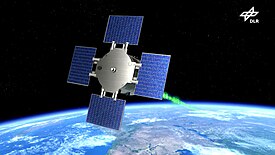 Render of the Eu:CROPIS satellite after launch | |
| Mission type | Life sciences research |
|---|---|
| Operator | German Aerospace Center[1] |
| COSPAR ID | 2018-099BB |
| SATCAT no. | 43807 |
| Mission duration | Planned: 1 year[1] Final: 1 year and 28 days |
| Spacecraft properties | |
| Bus | DLR Compact Satellite bus[2][3] |
| Manufacturer | DLR |
| Launch mass | 250 kg (550 lb)[1][3] |
| Dimensions | 1.0 m diameter x 1.13 m length[3] with panels deployed: 2.88 m wide[3] |
| Power | 520 W, 4 solar arrays, Li-ion batteries[1][3] |
| Start of mission | |
| Launch date | 3 December 2018[4] |
| Rocket | Falcon 9 (Block 5)[5] |
| Launch site | Vandenberg Air Force Base |
| Contractor | SpaceX[6] |
| End of mission | |
| Disposal | Decommissioned |
| Deactivated | 31 December 2019 |
| Orbital parameters | |
| Reference system | Geocentric |
| Regime | Low Earth (SSO) |
| Perigee altitude | 575 km (357 mi)[3] |
| Inclination | 98°[2][3] |
| Period | 10 h |
| Epoch | Planned[5] |
| Transponders | |
| Band | S band[3] |
Eu:CROPIS (Euglena and Combined Regenerative Organic-Food Production in Space) was a life science satellite developed by the German Aerospace Center (DLR) and intended to investigate the possibility of growing plants (specifically tomatoes) in different levels of gravity, such as that of the Moon and Mars,[1] as a sustainable food source using human urine for moisture and as the source of fixed nitrogen.
- ^ a b c d e "Eu:CROPIS". space.skyrocket.de. Retrieved 2018-09-26.
- ^ a b Institute of Space Systems, Status Report 2007-2016. (PDF) DLR.
- ^ a b c d e f g h "Eu CROPIS - eoPortal Directory - Satellite Missions". directory.eoportal.org. Retrieved 2018-09-26.
- ^ "SpaceX Twitter". twitter.com. 2018-12-02.
- ^ a b "UNITED STATES COMMERCIAL ELV LAUNCH MANIFEST". sworld.com.au. 2018-09-26.
- ^ DLR. "Eu:CROPIS – Greenhouses for the Moon and Mars". DLR Portal. Retrieved 2018-09-26.